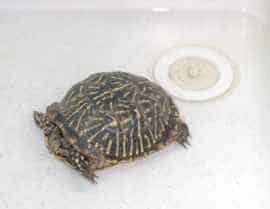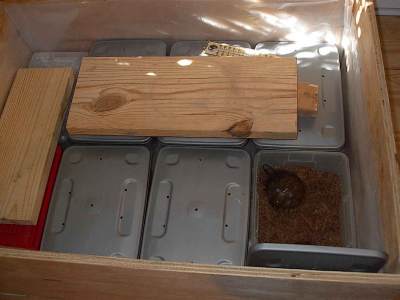Most box turtles live in geographic areas that require them to hibernate for three to four months of the year. During this time, food is scarce and outside temperatures are so low that box turtles cannot raise their body temperature high enough to maintain normal activity. Hibernation allows the box turtle to live until better times return in the spring. This time of the year is not a time of cozy sleep, but a dangerous time when bodily functions are barely keeping the box turtle alive. The heart rate slows, digestion stops and the turtle cannot voluntarily move or even open its eyes. Many unprepared wild and pet box turtles die during this period. This post will tell you everything you need to know about box turtle hibernation for box turtle pet keepers.
In this post you will learn:
- How box turtles hibernate in the wild
- Do’s and don’ts for box turtle hibernation
- How to prepare your turtle for hibernation
- How to build a hibernation box for your turtle
- And what to keep in mind when you decide to overwinter your turtle
Disclosure: This post contains affiliate links. At no extra cost for you, we may receive a commission if you purchase products mentioned below.
Box turtle hibernation in the wild
In the early fall, wild box turtles will begin to search for a protected place to spend the winter. An ideal site may be in the south face of a hill that is easy to dig into and above water level. Or it may be under the sheltering roots of a large tree which will be blanketed with fallen leaves by winter or a deep, abandoned gopher burrow.
It’s unlikely that your outdoor enclosure has an adequate spot for your turtle to hibernate unless you provide some additional materials. It’s also crucial to assess your box turtle’s health before you allow it to hibernate. There are many questions you need to ask and answer before your box turtle can safely hibernate. The first is should you even hibernate the turtle? If it is healthy, then yes. Hibernation helps turtles maintain normal thyroid activity, synchronize their reproduction cycles, and complete their normal life expectancies.
Here are do’s and don’ts for successful turtle hibernation
- Do take the time to prepare a proper hibernation place for your outdoor box turtle. Don’t leave it up to chance.
- Do choose an area that does not flood or collect run-off water. Your turtles could drown.
- Don’t hibernate sick, light weight or young box turtles. Keep them indoors in a roomy, well heated tank and feed them all winter long. Find more information about how to keep sick box turtles here.
- Do protect your hibernating box turtles from foraging wild animals like rats, mice or raccoons and from other pets that may break open their hibernation boxes or dens.
- Do check on your hibernating turtles once in awhile. You may find ill turtles above ground or the signs of wild animals foraging for food.
- Don’t let your box turtles hibernate in wet or soggy ground.
- Don’t force your turtle into hibernation. Some younger turtles or turtles from the Southeast of the US don’t require a hibernation.
Hatchling box turtles that were born just a few months earlier are especially at risk. Many do not survive their first winter. Weaken or underweight box turtles often don’t have the necessary reserves to survive a long winter. Even the healthiest turtle may come out of hibernation too soon and be caught above ground by a spring snowstorm and perish.
Many wild box turtles are eaten by foraging animals as they sleep, or freeze to death because they didn’t find satisfactory winter dens. You must be aware of all these things.
Therefore, only hibernate healthy, adult box turtles that have gained weight during the summer. Do not hibernate young, sick or underweight box turtles. Turtles that have worms or have respiratory illness will only get worse in hibernation. If you are unsure about the health of your box turtle, then, by all means take it to a reptile veterinarian and ask for a pre-hibernation check-up.
If you hibernate turtles outside, make sure they have areas of soft dirt and leaves to dig into that are above the water table and drains well. In late summer or early fall, begin to mound dirt and add leaves to the box turtle’s enclosure. This is also the time they begin to eat less and rest more. They are preparing their bodies for hibernation.
Feeding the turtle before hibernation
Several times in September and October, I place vitamin A (cod liver oil) onto favorite foods and feed it to them. This will insure they don’t become vitamin A deficient. In the last weeks before cooler weather appear, I stop feeding protein products and give them mostly dark, leafy vegetables, carrots and apples.
You can find more tips and information about the ideal box turtle diet here
Prepare the habitat for the box turtle hibernation
Depending on where you live in the United States or elsewhere, you may need to do more to prepare your outdoor enclosure for hibernating box turtles. In the Northeast or other states that have long, cold winters, you will need to make more preparations for the turtle’s hibernation. They must be able to dig into the ground deep enough to hibernate below the freeze line. This level changes during the winter so you need to prepare the ground deeply so the turtle can go down as far as it needs to.
Wild turtles have been found hibernating at depths of 2 feet (60 cm). This area should be protected from drying winds and snow drifts. Some people who live in areas that have very cold and long winters build artificial hibernation dens for their turtles. This is a good way to hibernate your box turtle since it allows you to monitor the temperature and health of your box turtles.
I live in the Midwest and in the wintertime, temperatures go below freezing. I hibernate my turtles in a hibernation box like the one outlined below. This way, I can check on them often and control the temperature. This method of hibernation is also recommended for box turtles that live in areas where they are not native.
Preparing the turtle for hibernation
If you are going to hibernate a box turtle you’ve kept inside all year, be sure to stop feeding it two weeks before you place it in the box.
During the two weeks you must also slowly reduce the temperature inside its living quarters by 5 degree Fahrenheit increments (around 3° C) so its body has a chance to acclimate to hibernation temperature. Once it becomes sedentary you may place it into the hibernation box.
You should also soak your turtle in about 3/4 inch of tepid water every 48 hours for about 20-30 minutes. This helps with their hydration and they can empty their intestines before hibernating.

How to build your own hibernation box?
To build your own hibernation box, you will need two boxes, one large and the second one small enough to fit inside the large one, but big enough for the box turtle and some moist sphagnum moss.
- Fill the large box half way with crumpled newspaper. Fill the smaller box (waterproof) with moist moss.
- Place your box turtle in the small box after it has already begun to hibernate on its own.
- Close the box but do not seal it.
- Put the small box into the larger box and pack the sides and top with more crumpled newspaper.
- Do not seal the box with tape. Remember, the turtle needs to breathe.
- Store the boxes in an area that is around 45-50° F (7-10 °C). Be sure the temperature doesn’t fluctuate a lot, but is steady. This could be an unheated basement, attic or crawl space. An unheated detached garage may get too cold. For your peace of mind, you can use a remote thermometer to check the temperature and humidity inside the hibernation box.
- Check the temperature of the hibernation area for several weeks before leaving the boxes there. Do not put your box turtles in the hibernation box directly without checking the temperature first.
- The artificial den should not be set directly on the ground. Use a plastic tarp so ground creatures cannot eat their way into the box.
- Check up on the turtle weekly.
- Listen to the box for sounds of the turtle moving around; it may need a drink.
- If it wakes up too often, the temperature may be too warm or it may be sick.
- Assess its health and decide if you can continue to hibernate it or if you should bring it out of hibernation and overwinter it indoors.

Once on the ground, you can place an old carpet piece over the box to add a little more insulation and reduce temperature fluctuations.
Ending the hibernation
Once your turtle is slowly becoming active again, you should keep it at a temperature of around 60° F (15° C) for another two days. After that, 65° F (18° C) for another two days. Only then you should release the turtle back into room temperature environment. Bringing the turtle back to too much heat in a short time can harm its health.
Overwintering box turtles
If you overwinter the box turtle, you must bring its core body temperature up slowly over the course of a week and begin to feed it regularly and keep it warm with summer-like temperatures and high humidity.
Overwintered box turtles should not be kept at sub-optimum temperatures and allowed to remain sluggish. This causes them to use too much of their energy reserves and they will become weaker.
Pin this post for later – just click on the picture below



I live in Sun City, AZ. I have an Eastern Box turtle and 3 western/ornate box turtles. They are outside all year. Last year they had pretty much dug in for hibernation by now. This year they are still pretty active during the day. Should I still offer food if they are still active??
Hi Kathy, thanks for reaching out. The length of the hibernation period may vary from year to year. I would still continue to feed them if they are active as usual. Place some cod liver oil for vitamin A onto their food and feed them leafy greens, apples and carrots – no more proteins. As long as they appear active and well, there is nothing to worry about and you should not stop feeding them. If you realize that they are changing their behavior and become less active, you can start the hibernation process with no more food and regular soakings.